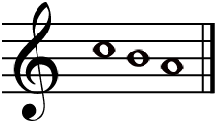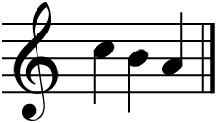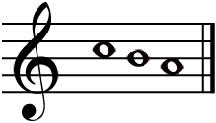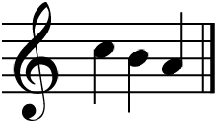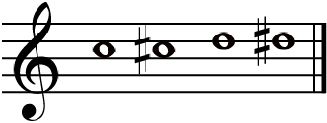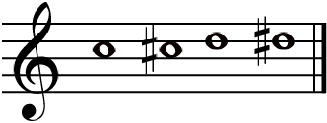Author: Matthew Davis
This Typst package is used to draw musical scales. This package can be used to write arbitrary notes, but is not intended to be used for entire songs.
Quickstart Examples
Example: D Major Scale
#import "@preview/staves:0.1.0": major-scale
#major-scale("treble", "D", 4)

Example: G Minor Arpeggio
#import "@preview/staves:0.1.0": arpeggio
#arpeggio("bass", "g", 2, note-duration: "crotchet")

Example: Custom Notes
#import "@preview/staves:0.1.0": stave
#stave("alto", "c", notes: ("C3", "D#4", "F3"), width: 7cm)

Documentation and Examples
A PDF version of this documentation (with slightly better formatting) is available here.
To see a showcase of what this package can do, see this example of a normal scale book: PDF and Typst source code.
Another example is a scale book which is a random mix of all scales: PDF and Typst source code. The purpose of this second one is to provide variety during your scales practices.
Stave
The foundational function is called stave. This is for writing just
clefs, clefs and key signatures, or clefs, key signatures and custom
notes. Typically as a user you should use the higher-level abstractions
such as arpeggio and major-scale (documented further down), if they
suit your needs. staves is exposed for creating custom scales which
are not yet supported (e.g. broken chords, scales in thirds etc). This
documentation section also explains parameters which are common to all
functions.
Usage
The arguments are:
clef: (Required) Allowed values are “treble", “bass”, “alto”, "tenor”. Drawing
a treble clef above a bass clef, linked as a double-stave (like for a
piano) is not yet supported.
key: (Required) Two possible forms.
-
Letter based: Uppercase for major, lowercase for minor, with
#orbappended. e.g."C","Db","f#" -
Number based, with a symbol: “5#” (or “5s”) for 5 sharps, “2b” for 2 flats
notes: An (optional) array of strings representing notes to play sequentially.
Chords are not supported. e.g.
-
“C4” is middle C
-
“C5” is the C an octave above middle C.
-
“Db4” or “C#4” is a semitone above middle C
-
“B3” is a semitone below middle C
-
“Bn3” has an explicit natural accidental ♮ infront of it
-
“Fx3” is an F3 with a double sharp, drawn as an 𝄪
(Formats such as “F##3” to show ♯♯ are not supported yet.)
-
double flats are not yet supported.
notes-per-stave: (Optional) Used to break a long scale over multiple lines. Line breaks
will be inserted after every group of this many notes. If omitted, all
notes will be placed on the first stave. Page breaks are blocked between
staves of the same scale.
note-duration: (optional) Allowed values are “whole", “quarter”, “semibreve”,
"crotchet”. Default is “whole” note. All notes are the same duration.
width: (Optional) If provided, sets the length of the stave lines. It omitted
(or auto), the stave lines will be stretched to the available space.
If the page width itself is auto, a sensible default will be used.
line-sep: (Optional) A
length used to
set the vertical spacing of the 5 stave lines (within a given stave).
Note that this is a length with units, e.g. 3cm, not just 3.
equal-note-head-space: true or false. Defaults to true. If true, note heads will be
equally spaced. Some of this space will be taken up with accidentals. If
false, adding an accidental to a note will shift the note head further
right. true looks better (in my opinion), but false is useful when
trying to squish many notes into one stave, to avoid accidentals
overlapping with previous note heads.
Examples
To draw just a key signature, omit the notes argument
#import "@preview/staves:0.1.0": stave
#stave("treble", "D")
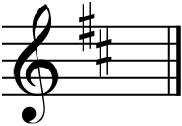
Here is an example of including notes. Legerlines are supported.
#stave("treble", "F", notes: ("F4", "C5", "F5", "C6", "F6", "C6", "F5", "C5", "F4"))
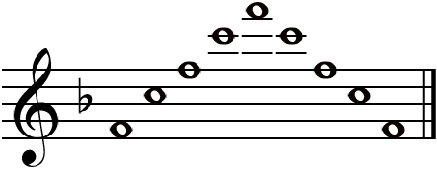
Note that accidentals are independent of the key signature. For the example of F major, the key contains B flat. A “B” note will be drawn with no accidental, so it is flattenned by the key signature. A “Bb” will have a redundant flat accidental drawn. “Bn” will have an explicit natural accidental. This behavior may change in future versions.
#stave("bass", "F", notes: ("C2", "B2", "Bb2", "B2", "Bn2"))
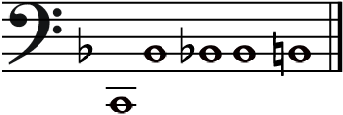
The note-duration argument can be used to change the note symbol.
note-duration: whole
|
note-duration: quarter
|
note-duration: semibreve
|
note-duration: crotchet
|
Spacing and Sizing
The notes-per-stave argument can be used to split up long scales into
multiple lines.
#major-scale("treble", "D", 4, num-octaves: 2, notes-per-stave: 16)

The width argument can be used to adjust the overall width.
#stave("treble", "f", width: 7cm)
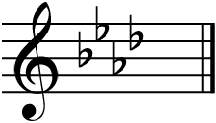
The line-sep argument can be used to adjust the vertical spacing
between stave lines. Note that this must be a
length (i.e.
includes a unit like “cm”, “inches” etc) not just a
float.
line-sep: 0.2cm
|
line-sep: 0.5cm
|
equal-note-head-space is used to adjust the spacing based on whether
there are accidentals. True means the space between notes is equal
regardless of whether there is an accidental. False means there is an
equal space between each note and the accidental of the next note. (i.e.
unequal space between each note head.)
equal-note-head-space: true
|
equal-note-head-space: false
|
Major Scales
The major-scale function is for writing major scales.
Usage
clef: (Required) Allowed values are “treble", “bass”, “alto”, "tenor”. (Same
as for stave.)
key: (Required) e.g. “A”, “Bb”, “C#”. Uppercase only.
start-octave: (Required) integer. e.g. 4 is the octave starting from middle C. 5 is
the octave above that.
num-octaves: Optional, defaults to 1.
notes-per-stave: (Optional) Used to break a long scale over multiple lines. Line breaks
will be inserted after every group of this many notes. If omitted, all
notes will be placed on the first stave. Page breaks are blocked between
staves of the same scale.
note-duration: (optional) Allowed values are “whole", “quarter”, “semibreve”,
"crotchet”. Default is “whole” note. All notes are the same duration.
width: (Optional) If provided, sets the length of the stave lines. It omitted
(or auto), the stave lines will be stretched to the available space.
If the page width itself is auto, a sensible default will be used.
line-sep: (Optional) A
length used to
set the vertical spacing of the 5 stave lines (within a given stave).
Note that this is a length with units, e.g. 3cm, not just 3.
equal-note-head-space: true or false. Defaults to true. If true, note heads will be
equally spaced. Some of this space will be taken up with accidentals. If
false, adding an accidental to a note will shift the note head further
right. true looks better (in my opinion), but false is useful when
trying to squish many notes into one stave, to avoid accidentals
overlapping with previous note heads.
Examples
Example: D Major Scale
#import "@preview/staves:0.1.0": major-scale
#major-scale("treble", "D", 4)

You can write a 2 octave scale with num-octaves: 2.
Minor Scale
The minor-scale function is for writing natural and harmonic minor
scales. The usage is the same as for major-scale, plus an additional
minor-type argument.
Usage
clef: (Required) Allowed values are “treble", “bass”, “alto”, "tenor”. (Same
as for stave.)
key: (Required) e.g. “A”, “Bb”, “c#”. Uppercase or lowercase.
start-octave: (Required) integer. e.g. 4 is the octave starting from middle C. 5 is
the octave above that.
num-octaves: Optional, defaults to 1.
minor-type: Defaults to “harmonic”. Allowed values are “natural", "harmonic”.
Melodic minor scales are not yet supported.
seventh: Where the raised seventh would be a double sharp, configure how it is
shown. Allowed values are “n", "x”. See examples below.
notes-per-stave: (Optional) Used to break a long scale over multiple lines. Line breaks
will be inserted after every group of this many notes. If omitted, all
notes will be placed on the first stave. Page breaks are blocked between
staves of the same scale.
note-duration: (optional) Allowed values are “whole", “quarter”, “semibreve”,
"crotchet”. Default is “whole” note. All notes are the same duration.
width: (Optional) If provided, sets the length of the stave lines. It omitted
(or auto), the stave lines will be stretched to the available space.
If the page width itself is auto, a sensible default will be used.
line-sep: (Optional) A
length used to
set the vertical spacing of the 5 stave lines (within a given stave).
Note that this is a length with units, e.g. 3cm, not just 3.
equal-note-head-space: true or false. Defaults to true. If true, note heads will be
equally spaced. Some of this space will be taken up with accidentals. If
false, adding an accidental to a note will shift the note head further
right. true looks better (in my opinion), but false is useful when
trying to squish many notes into one stave, to avoid accidentals
overlapping with previous note heads.
Examples
Example: D Harmonic Minor Scale
#import "@preview/staves:0.1.0": minor-scale
#minor-scale("treble", "D", 4)

Example: Bb Natural Minor Scale
#minor-scale("bass", "Bb", 2, minor-type: "natural")

Note that for keys with a sharp, the raised 7th can be written as a double sharp, or a natural of the next note.
#minor-scale("treble", "F#", 4, seventh: "n")

#minor-scale("treble", "F#", 4, seventh: "x")

Arpeggio
The arpeggio function is for writing arpeggios.
Usage
The arguments are the same as for major-scale.
clef: (Required) Allowed values are “treble", “bass”, “alto”, "tenor”. (Same
as for stave.)
key: (Required) e.g. “A”, “Bb”, “C#”. Uppercase for major, lowercase for
minor. Do not include a number for the octave.
start-octave: (Required) integer. e.g. 4 is the octave starting from middle C. 5 is
the octave above that.
num-octaves: Optional, defaults to 1.
notes-per-stave: (Optional) Used to break a long scale over multiple lines. Line breaks
will be inserted after every group of this many notes. If omitted, all
notes will be placed on the first stave. Page breaks are blocked between
staves of the same scale.
note-duration: (optional) Allowed values are “whole", “quarter”, “semibreve”,
"crotchet”. Default is “whole” note. All notes are the same duration.
width: (Optional) If provided, sets the length of the stave lines. It omitted
(or auto), the stave lines will be stretched to the available space.
If the page width itself is auto, a sensible default will be used.
line-sep: (Optional) A
length used to
set the vertical spacing of the 5 stave lines (within a given stave).
Note that this is a length with units, e.g. 3cm, not just 3.
equal-note-head-space: true or false. Defaults to true. If true, note heads will be
equally spaced. Some of this space will be taken up with accidentals. If
false, adding an accidental to a note will shift the note head further
right. true looks better (in my opinion), but false is useful when
trying to squish many notes into one stave, to avoid accidentals
overlapping with previous note heads.
Example
Example: F Major Arpeggio
#arpeggio("bass", "F", 2, num-octaves: 2)

Chromatic Scales
chromatic-scale is used to write chromatic scales (every semitone
between two notes). The arguments are:
Usage
clef: (Required) Allowed values are “treble", “bass”, “alto”, "tenor”. (Same
as for stave.)
key: (Required) e.g. “A”, “Bb”, “C#”. Uppercase for major, lowercase for
minor. Do not include a number for the octave.
start-octave: (Required) integer. e.g. 4 is the octave starting from middle C. 5 is
the octave above that.
num-octaves: Optional, defaults to 1.
side: ”sharp", "flat”
notes-per-stave: (Optional) Used to break a long scale over multiple lines. Line breaks
will be inserted after every group of this many notes. If omitted, all
notes will be placed on the first stave. Page breaks are blocked between
staves of the same scale.
note-duration: (optional) Allowed values are “whole", “quarter”, “semibreve”,
"crotchet”. Default is “whole” note. All notes are the same duration.
width: (Optional) If provided, sets the length of the stave lines. It omitted
(or auto), the stave lines will be stretched to the available space.
If the page width itself is auto, a sensible default will be used.
line-sep: (Optional) A
length used to
set the vertical spacing of the 5 stave lines (within a given stave).
Note that this is a length with units, e.g. 3cm, not just 3.
equal-note-head-space: true or false. Defaults to true. If true, note heads will be
equally spaced. Some of this space will be taken up with accidentals. If
false, adding an accidental to a note will shift the note head further
right. true looks better (in my opinion), but false is useful when
trying to squish many notes into one stave, to avoid accidentals
overlapping with previous note heads.
Examples
Example: D Chromatic Scale
#chromatic-scale("treble", "D", 4, notes-per-stave: semitones-per-octave + 1)
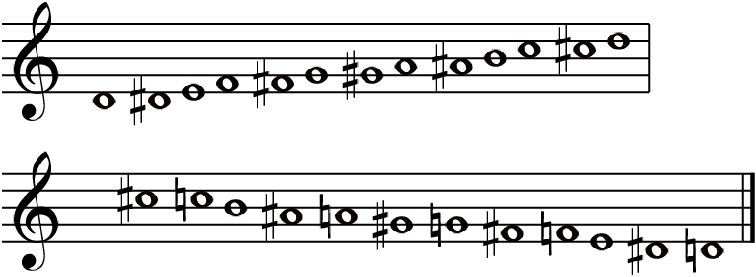
Example: G Chromatic Scale
#chromatic-scale("bass", "G", 2, side: "flat", note-duration: "crotchet", notes-per-stave: semitones-per-octave + 1)

Modes
mode-by-index is used to write modal scales. This function takes the
key of the corresponding major scale (ionian), and an integer
(one-indexed) to specify which mode relative to that ionian.
This function is designed so that users can easily write all modes of a
given key signature with a simple for loop. If you know the word (e.g.
“phrygian”) and want to programatically convert that to the relevant
integer, use the constant mode-names (documented below). Watch out
though. Typst indexes lists from 0, whereas this function treats 1 as
the first mode (ionian), because musicians tend to count from 1.
Usage
clef: (Required) Allowed values are “treble", “bass”, “alto”, "tenor”. (Same
as for stave.)
key: (Required) e.g. “A”, “Bb”, “C#”. Uppercase for major, lowercase for
minor. Do not include a number for the octave.
start-octave: (Required) integer. e.g. 4 is the octave starting from middle C. 5 is
the octave above that. This refers to the octave of the ionian, not the
first note of the mode.
mode-index: (Required) integer. one-indexed. 1 is ionian, 0 is dorian etc.
num-octaves: Optional, defaults to 1.
side: ”sharp", "flat”
notes-per-stave: (Optional) Used to break a long scale over multiple lines. Line breaks
will be inserted after every group of this many notes. If omitted, all
notes will be placed on the first stave. Page breaks are blocked between
staves of the same scale.
note-duration: (optional) Allowed values are “whole", “quarter”, “semibreve”,
"crotchet”. Default is “whole” note. All notes are the same duration.
width: (Optional) If provided, sets the length of the stave lines. It omitted
(or auto), the stave lines will be stretched to the available space.
If the page width itself is auto, a sensible default will be used.
line-sep: (Optional) A
length used to
set the vertical spacing of the 5 stave lines (within a given stave).
Note that this is a length with units, e.g. 3cm, not just 3.
equal-note-head-space: true or false. Defaults to true. If true, note heads will be
equally spaced. Some of this space will be taken up with accidentals. If
false, adding an accidental to a note will shift the note head further
right. true looks better (in my opinion), but false is useful when
trying to squish many notes into one stave, to avoid accidentals
overlapping with previous note heads.
Examples
Example: G Dorian
#mode-by-index("treble", "G", 4, 2)

To write all modes with 2 sharps use a for loop:
#for mode-index in range(1, num-letters-per-octave + 1) {
mode-by-index("treble", "D", 4, mode-index)
}
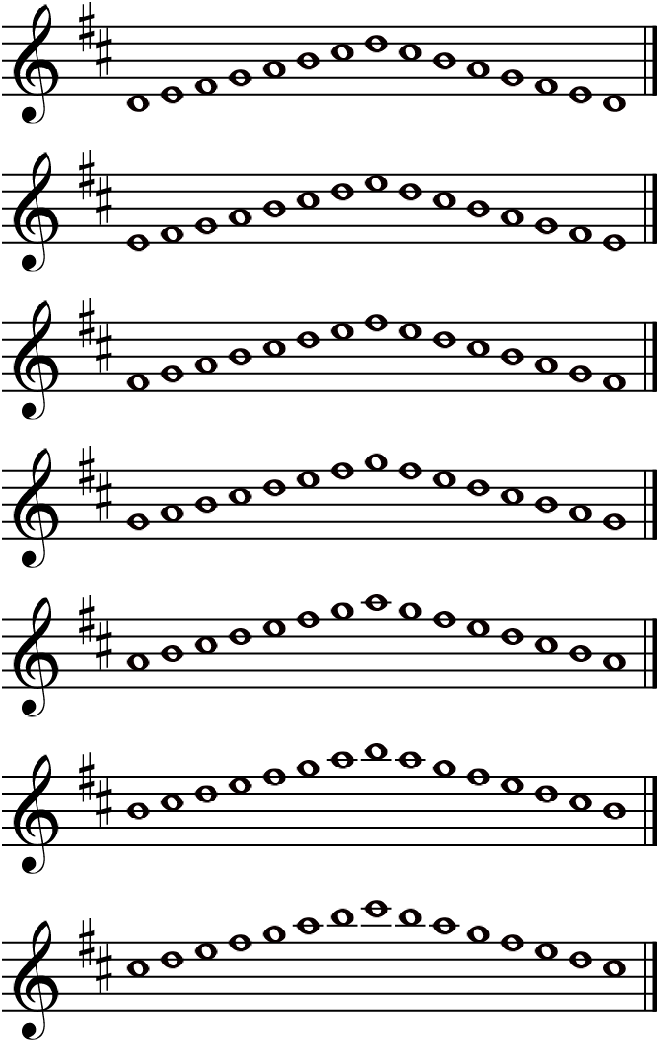
Constants
There are some constants which are exposed by the library. They may make it easier to write scale books. However the structure, value and presence of these should be considered unstable, and is likely to change in future versions.
all-clefs: (“treble”, “bass”, “alto”, “tenor”)
key-data: (major: (“Cb”, “Gb”, “Db”, “Ab”, “Eb”, “Bb”, “F”, “C”, “G”,
“D”, “A”, “E”, “B”, “F#”, “C#”), minor: (“ab”, “eb”, “bb”, “f”, “c”,
“g”, “d”, “a”, “e”, “b”, “f#”, “c#”, “g#”, “d#”, “a#”))
all-notes-from-c: (sharp: (“C”, “C#”, “D”, “D#”, “E”, “F”, “F#”, “G”,
“G#”, “A”, “A#”, “B”), flat: (“C”, “Db”, “D”, “Eb”, “E”, “F”, “Gb”, “G”,
“Ab”, “A”, “Bb”, “B”))
semitones-per-octave: 12
middle-c-octave: 4
all-letters-from-c: (“C”, “D”, “E”, “F”, “G”, “A”, “B”)
num-letters-per-octave: 7
sharp-order: (“F”, “C”, “G”, “D”, “A”, “E”, “B”)
mode-names: (“ionian”, “dorian”, “phrygian”, “lydian”, “mixolydian”,
“aeolian”, “locrian”)
Setting Defaults
To set a default, such as the same note-duration for your whole
document, use the with
approach
(for each different scale type):
#let major-scale = major-scale.with(note-duration: "crotchet")
#let minor-scale = minor-scale.with(note-duration: "crotchet")
Implementation Details
This package uses a canvas from the
CeTZ package.
License Details
This library uses SVG images for clefs, accidentals etc. These files
came from Wikipedia, and are in the public domain. They are not covered
by the same license as the rest of the package. Source URLs for these
SVGs are listed in
/assets/README.md
